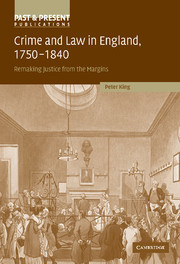Book contents
- Frontmatter
- Contents
- Preface
- List of figures
- List of tables
- 1 Shaping and remaking justice from the margins. The courts, the law and patterns of lawbreaking 1750–1840
- Part I Juveniles
- 2 The rise of juvenile delinquency in England 1780–1840: changing patterns of perception and prosecution
- 3 The punishment of juvenile offenders in the English courts 1780–1830. Changing attitudes and policies
- 4 The making of the reformatory. The development of informal reformatory sentences for juvenile offenders 1780–1830
- Part II Gender
- Part III Non-lethal violence
- Part IV The attack on customary rights
- Index
- Past and Present Publications
4 - The making of the reformatory. The development of informal reformatory sentences for juvenile offenders 1780–1830
Published online by Cambridge University Press: 25 July 2009
- Frontmatter
- Contents
- Preface
- List of figures
- List of tables
- 1 Shaping and remaking justice from the margins. The courts, the law and patterns of lawbreaking 1750–1840
- Part I Juveniles
- 2 The rise of juvenile delinquency in England 1780–1840: changing patterns of perception and prosecution
- 3 The punishment of juvenile offenders in the English courts 1780–1830. Changing attitudes and policies
- 4 The making of the reformatory. The development of informal reformatory sentences for juvenile offenders 1780–1830
- Part II Gender
- Part III Non-lethal violence
- Part IV The attack on customary rights
- Index
- Past and Present Publications
Summary
As we have seen in the last chapter, the English criminal justice system was struggling to find appropriate sentencing options for the rising tide of juvenile offenders that was coming into the courts by the early nineteenth century. ‘In time of war’, as Wade pointed out in his Treatise on the Police and Crime of the Metropolis in 1829, ‘the sea service … afforded a convenient outlet for profligate youths, but now it is with great difficulty persons can be found to take them, as is proved by the experience of the Marine Society’. Wade was also clear that the alternatives were far from satisfactory. ‘The methods now employed to dispose of delinquent children failing to reform them or relieve society from their presence, it is certainly expedient a new experiment should be tried’, he wrote. ‘This class of offenders … may be imprisoned and whipped, … (or) transported for a limited term. Neither of these punishments serves any salutary end, and when applied, the magistrates generally take occasion to remark, at the time, that they have resorted to them merely because they have no other way of disposing of the objects before them.’ Wade's solution was compulsory exile, and assisted emigration in various less drastic forms did emerge as a major policy option in the late 1820s and 1830s.
- Type
- Chapter
- Information
- Crime and Law in England, 1750–1840Remaking Justice from the Margins, pp. 142 - 162Publisher: Cambridge University PressPrint publication year: 2006
- 1
- Cited by



